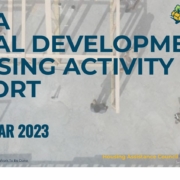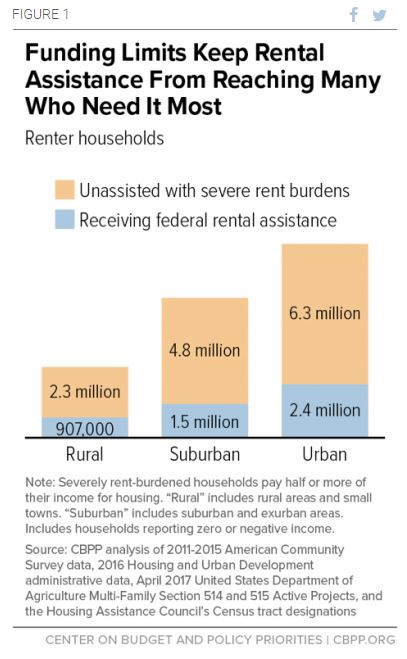HAC News Formats. pdf
May 11, 2017
Vol. 46, No. 10
Final FY17 spending agreement supports USDA and HUD housing • Trump’s signing statement singles out Native American Housing Block Grants • FY18 funding process uncertain • Duty to Serve plans released for comment • USDA RD publishes FY17 voucher notice • New Markets Tax Credit allocations available • USDA to continue stakeholder calls on multifamily housing • HUD reopens Moving to Work comment period • Farmworkers are now older and less likely to migrate, research shows • Rural Voices considers “Action for a Rapidly Changing Rural America • REGISTER TO KEEP YOUR HAC NEWS SUBSCRIPTION ACTIVE
HAC News Formats. pdf
May 11, 2017
Vol. 46, No. 10
Final FY17 spending agreement supports USDA and HUD housing. The omnibus spending bill for FY17 provides full funding for USDA and HUD housing programs, rejecting cuts proposed by the Trump Administration. It increases funding for Section 502 direct loans, Section 523 self-help, and Section 515, and provides the full $1.405 billion in Section 521 Rental Assistance funding requested by the Obama Administration. For details on the bill’s provisions relating to rural rental housing preservation, visit HAC’s website.
USDA Rural Dev. Prog.
(dollars in millions) |
FY16
Approp.
|
FY17 Obama Budget Proposal
|
FY17 House Cmte. Bill (H.R. 5054)
|
FY17 Senate Cmte. Bill
(S. 2956)
|
FY17 Omnibus (H.R. 244)
|
|
502 Single Fam. Direct
Self-Help setaside
|
$900
5
|
$900
0
|
$1,000
5
|
$900
5
|
$1,000
5
|
|
502 Single Family Guar.
|
24,000
|
24,000
|
24,000
|
24,000
|
24,000
|
|
504 VLI Repair Loans
|
26.3
|
26.3
|
26.3
|
26.3
|
26.3
|
|
504 VLI Repair Grants
|
28.7
|
28.7
|
28.7
|
28.7
|
28.7
|
|
515 Rental Hsg. Direct Lns.
|
28.4
|
33.1
|
35
|
40
|
35
|
|
514 Farm Labor Hsg. Lns.
|
23.9
|
23.9
|
23.9
|
23.9
|
23.9
|
|
516 Farm Labor Hsg. Grts.
|
8.3
|
8.3
|
8.3
|
8.3
|
8.3
|
|
521 Rental Assistance
|
1,390
|
1,405
|
1,405
|
1,405
|
1,405
|
|
523 Self-Help TA
|
27.5
|
18.5
|
30
|
27.5
|
30
|
|
533 Hsg. Prsrv. Grants
|
3.5
|
0
|
5
|
3.5
|
5
|
|
538 Rental Hsg. Guar.
|
150
|
230
|
200
|
230
|
230
|
|
Rental Prsrv. Demo. (MPR)
|
22
|
19.4
|
22
|
22
|
22
|
|
542 Rural Hsg. Vouchers
|
15
|
18
|
18
|
18
|
19.4
|
|
Rural Cmnty. Dev’t Init.
|
4
|
4
|
4
|
4
|
4
|
The omnibus provides full renewal funding for HUD programs, including CDBG, HOME, and SHOP, which would have been eliminated by the Trump Administration’s proposal . It also includes $10 million for Section 202 that HUD can use either for new construction – the first such funding since 2011 – or for new Senior Preservation Rental Assistance Contracts.
|
HUD Program
(dollars in millions)
|
FY16
Approp.
|
FY17 Obama Budget Proposal
|
FY17 House Subcmte. Bill
(H.R. 5394)
|
FY17 Senate Cmte. Bill (H.R. 2844)
|
FY17 Omnibus (H.R. 244)
|
|
Cmty. Devel. Fund
CDBG
|
$3,060
3,000
|
$2,880
2,800
|
$3,060
3,000
|
$3,000
3,000
|
$3,060
3,000
|
|
HOME
|
950
|
950
|
950
|
950
|
950
|
|
Self-Help Homeownshp. (SHOP)
|
10
|
10a
|
10
|
10
|
10
|
|
Tenant-Based Rental Assistance
VASH setaside
|
19,628
60
|
20,854
7c
|
20,189
7c
|
20,432
57
|
20,292
47d
|
|
Project-Based Rental Asstnce.
|
10,622
|
10,816
|
10,901
|
10,901
|
10,816
|
|
Public Hsg. Capital Fund
|
1,900
|
1,865
|
1,900
|
1,925
|
1,942
|
|
Public Hsg. Operating Fund
|
4,500
|
4,569
|
4,500
|
4,675
|
4,400
|
|
Choice Neighbrhd. Initiative
|
125
|
200
|
100
|
80
|
137.5
|
|
Native Amer. Hsg. Block Grant
|
650
|
700
|
655
|
647
|
654
|
|
Homeless Assistance Grantsb
|
2,250
|
2,664
|
2,487
|
2,330
|
2,383
|
|
Hsg. Opps. for Persons w/ AIDS
|
335
|
335
|
335
|
335
|
356
|
|
202 Hsg. for Elderly
|
432.7
|
505
|
505
|
505
|
502.4
|
|
811 Hsg. for Disabled
|
150.6
|
154
|
154
|
154
|
146.2
|
|
Fair Housing
|
65.3
|
70
|
65.3
|
65
|
65.3
|
|
Healthy Homes & Lead Haz. Cntl.
|
110
|
110
|
130
|
135
|
145
|
|
Housing Counseling
|
47
|
47
|
55
|
47
|
55
|
|
Local Housing Policy Grants
|
–
|
300
|
–
|
–
|
–
|
a. The FY17 Obama Administration budget, like past budget requests, proposed to make SHOP a setaside in HOME. b. Includes the Rural Housing Stability Program, which is not yet operational. c. Tribal VASH setaside. d. $7 million for tribal VASH and $40 million for VASH.
Trump’s signing statement singles out Native American Housing Block Grants. When he signed the FY17 omnibus appropriations bill into law, President Trump issued a statement commenting on some of its provisions. Signing statements are not unusual. This one says certain programs, including Native American Housing Block Grants, minority business development, and funding for historically black colleges and universities, may conflict with the Constitution’s equal protection clause because they “allocate benefits on the basis of race, ethnicity, and gender.” A response from the National American Indian Housing Council points out that these Native American grants “are rooted in the United States’ trust responsibilities and treaty obligations towards Indian Tribes and Native Americans” and are not based on race or ethnicity.
FY18 funding process uncertain. The Trump Administration’s budget proposal, expanding on the outline released in March, is expected in late May. The 2011 Budget Control Act’s spending caps require substantial cuts in both defense and non-defense spending for FY18. The March “skinny budget” did not conform to those caps, and many members of Congress also object to them. It is not clear whether a compromise on spending limits and then an agreement on appropriations details can be worked out before the year begins on October 1, so a continuing resolution may be needed again to keep the government operating.
Duty to Serve plans released for comment. Comments are due July 10 on Fannie Mae’s and Freddie Mac’s proposed Duty to Serve Underserved Markets Plans, which describe specific activities the enterprises propose to undertake from 2018 to 2020 to fulfill their obligations to serve three underserved markets: manufactured housing, affordable housing preservation, and rural markets. Access HAC resources on DTS here.
USDA RD publishes FY17 voucher notice. The annual notice governing the Section 542 voucher program is now available online. For more information, contact Stephanie B.M. White, RD, 202-720-1615.
New Markets Tax Credit allocations available. Apply by June 21 for a portion of the CDFI Fund’s $3.5 billion of NMTC allocation authority. Informational webcasts or conference calls will be announced at https://www.cdfifund.gov. For more information, contact NMTC staff at 202-653-0421.
USDA to continue stakeholder calls on multifamily housing. The calls’ dates and times will be emailed to people who register by contacting Timothy James, USDA, 919-873-2056. Those who have registered in the past do not need to do so again. (These are not the same as the Section 538 stakeholder calls described in the HAC News, 1/19/17.)
HUD reopens Moving to Work comment period. In January, HUD published a notice seeking comment on the proposed operations for PHAs joining the MTW demonstration. (See HAC News, 2/2/17.) HUD has revised the notice and reopened the comment period through June 5. For more information, contact Marianne Nazzaro, HUD.
Farmworkers are now older and less likely to migrate, research shows. Data from the U.S. Department of Labor’s National Agricultural Worker Survey shows the share of farmworkers in the 20-34 age group has fallen from more than half in 2000 to under 40% in 2016. Only 15% migrate for work. Workers have been employed an average of seven years by their current employers, and earn $15,000-$20,000 annually from farmwork. Many families have more than one wage earner and 25% of farmworkers have at least one nonfarm job, so total median family income ranges from $20,000 to $25,000. “Hired U.S. and California Farm Workers are Aging and Settling: Comparisons from 1990, 2000, and 2016” is in the Western Rural Development Center’s magazine.
Rural Voices considers “Action for a Rapidly Changing Rural America.” The spring issue of HAC’s magazine reports on some of the learning and brainstorming that occurred at the HAC 2016 Rural Housing Conference, with articles based on keynote addresses and issue papers from the conference, along with action recommendations from participant roundtables.
|
REGISTER TO KEEP YOUR HAC NEWS SUBSCRIPTION ACTIVE. Thank you for reading the HAC News, the premier source of information on rural housing for over 45 years. HAC is developing a new and improved distribution system for the newsletter. As a part of this process, we need you to update your registration to the HAC News. We estimate the entire process will take less than a minute. You must complete the registration process by May 30, or you will no longer receive direct mailing of the HAC News. Questions? Contact portal@ruralhome.org.
|



